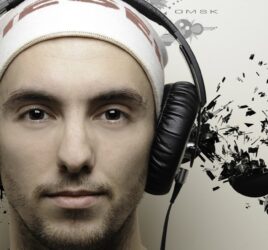
Too ‘fat’ to eat? A plea for experimental research on anorexia nervosa
““I’m so afraid of becoming fat, that I hardly dare eat” 16-year old Jane says, while in reality she is so skinny that even the smallest clothing size is too big for fit. I met Jane at the Accare Center for Eating Disorders, which she visited together with her parents in order to seek help for her eating problems. Starting the previous summer, Jane has gradually been eating less. First she cut out candy, then she started throwing away her lunch at school, and so on. During the Christmas break it became clear that Jane really had a problem. By that time she had already lost 7 kg, and would panic every time she had to eat something other than yoghurt or lettuce. According to the Diagnostic and Statistical Manual of Mental Disorders (DSM-5; APA, 2013) Jane’s symptoms fulfilled the criteria of Anorexia Nervosa, a disorder with a major impact not only on the physical and psychological well-being of the patient, but also on ‘bystanders’ witnessing a loved one becoming emaciated.
“Anorexia Nervosa, a disorder with a major impact not only on the physical and psychological well-being of the patient, but also on ‘bystanders’”
Unfortunately, Jane’s story is not an exception. Every year over 100 girls, and some boys, come to our treatment center with similar stories. It makes one wonder what is going on here. How do these adolescents succeed in restricting their food intake, while actually they are starving? By nature, food has a high reward value, even more so for people who have been deprived of food. So how and why do individuals with anorexia overcome their natural drive to eat?
According to some theoretical models, and as Jane’s statement suggests, individuals with anorexia attach great value to how they think they look. Disordered eating behaviors might be a way to control one’s weight and shape (e.g., Fairburn et al., 2003). However, other factors may also be involved. For example, according to some researchers, people with problems in handling emotions and social functioning may be at risk for developing anorexia (e.g., Treasure, Corfield & Cardi, 2012). Others see restrictive eating behaviors as extreme, out-of-control habits (e.g., Walsh, 2013); these behaviors may begin as dieting directed towards a clear goal, but after many repetitions they become “overtrained” and resistant to change. These are only three ways that scientific theories have tried to explain disordered eating behaviors in anorexia. Nevertheless, mainly due to a lack of solid empirical evidence, we still do not know which factors underlie the emergence and maintenance of anorexia.
“we still do not know which factors underlie the emergence and maintenance of anorexia”
The need for a theory firmly grounded in empirical evidence becomes strikingly clear when we consider the treatments available for anorexia (Hay et al., 2014). For adults, no particular psychotherapeutic method is currently seen as the most effective and, overall, a year after treatment less than one-fifth of patients have recovered fully (Zipfel et al., 2014). Moreover, relapse after successful treatment is common. While for adolescents with anorexia the prognosis is somewhat brighter in that family therapy may be effective, how exactly this works is unclear. The lack of good treatment options for anorexia is problematic given the high psychological, social, and financial costs associated with anorexia for patients and their families, as well as the significant economic costs for society in general (Schmidt et al., 2016).
So now that the problem is clear, what should we do about it? Well-designed experimental studies seem to be necessary for reaching “the next level” in anorexia treatment. Only by manipulating presumed causal factors and measuring the effects on core symptoms of anorexia, we can determine whether these factors are truly involved in causing anorexia. Only this gives us clues as to which factors we should address in therapy. Until we know more about the mechanisms underlying the development/maintenance of anorexia, large-scale randomized controlled treatment studies might simply be a waste of our resources (Fairburn, 2005). All the more considering that research in individuals with anorexia comes with many challenges among which the nature of anorexia symptoms (e.g., denial of illness), the low base rate of anorexia and high drop-out rates (Agras et al., 2003).
“Well-designed experimental studies seem to be necessary for reaching “the next level” in anorexia treatment.”
Before conducting large treatment studies, we should first conduct several series of small-scale experimental studies in which theory-driven factors are singled out and brought under manipulation. That way, we can start distinguishing the key factors that are crucially involved in the persistence of anorexia (Jansen, 2001). For example, researchers experimentally tested the influence of negative emotions on eating disorder symptoms in anorexia (Wildes et al., 2012). Individuals with anorexia had to watch either a negative or a neutral movie clip. It appeared that eating disorder symptoms increased after watching a negative movie, but not after watching a neutral movie. Hopefully, such research will help to pave the way for further development of evidence-based treatment approaches, which will eventually help individuals such as Jane to break through the persistent cycle of anorexia nervosa.
References:
Agras, W. S., Brandt, H. A., Bulik, C. M., Dolan-Sewell, R., Fairburn., C. G., … Wilfley, D. E. (2004). Report of the National Institutes of Health workshop on overcoming barriers to treatment research in anorexia nervosa. International Journal of Eating Disorders, 35, 509 – 521.
American Psychiatric Association (2013). Diagnostic and Statistical Manual of Mental Disorders, 5th Edn. Washington, DC: APA.
Fairburn, C. G. (2005). Evidence-based treatment of anorexia nervosa. International Journal of Eating Disorders, 37, S26–30.
Fairburn, C. G., Cooper, Z. & Shafran, R. (2003). Cognitive behavior therapy for eating disorders: a “transdiagnostic” theory and treatment. Behaviour Research and Therapy, 41, 509 – 528.
Hay, P ., Chinn, D., Forbes, D., Madden, S., Newton, R., … Ward, W. (2014). Royal Australian and New Zealand College of Psychiatrists clinical practice guidelines for the treatment of eating disorders. Australian & New Zealand Journal of Psychiatry, 48, 977 –1008.
Jansen, A. (2001). Towards effective treatment of eating disorders: nothing is as practical as a good theory. Behaviour Research and Therapy, 39, 1007–1022.
Schmidt, U., Adan, R., Böhm, I., Campbell, I., Dingemans, A., … Zipfel, S. (2016). Eating disorders: the big issue. Lancet Psychiatry, 3, 313-315.
Treasure, J., Corfiels, F., & Cardi, V. (2012). A three-phase model of the social emotional functioning in eating disorders. European Eating Disorders Review, 20, 431–438.
Walsh, B. T. (2013). The enigmatic persistence of anorexia nervosa. American Journal of Psychiatry, 170, 477-484.
Wildes, J. E., Marcus, M. D., Bright, A. C., & Dapelo, M., M. (2012). Emotion and eating disorder symptoms in patients with anorexia nervosa: An experimental study. International Journal of Eating Disorders, 45, 876–882.
Zipfel, S., Wild, B., Groβ, G., Friederich, H. -C., Teufel, M., … Herzog, W. (2014). Focal psychodynamic therapy, cognitive behaviour therapy, and optimised treatment as usual in outpatients with anorexia nervosa (ANTOP study): randomised controlled trial. Lancet, 383, 127–137.
Note:
Image by goodinteractive in the public domain under CC0



